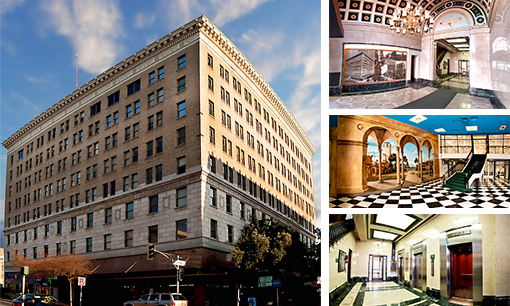| 제목 | [DAIKIN] OFFICE BUILDING - T W Patterson Building | 작성일 | 16-06-16 10:52 |
| 글쓴이 | 최고관리자 | 조회수 | 4,326 |
본문
CASE STUDY
Office Building
Name
T.W. Patterson Building
Location
Fresno, CA, USA
Building size
152,000 ft2 total space
92,000 ft2 served by new equipment
Issue
Upgrading to a more efficient and eco-friendly closed-loop water-cooled chiller system
Solution
(1) 284 ton Daikin Magnitude® frictionless magnetic-bearing
chiller
Daikin Magnitude Maximizes Payback for Upgrade in Historic
California Building
Issues
The first multi-story building to feature air conditioning in the U.S. back in the 1920s continues to set the pace for innovation today. In fact, a recent upgrade project gave building ownership and their working partners a chance to show advanced technology and problem solving
at its finest.
Three years after its 1923 opening, the T.W. Patterson Building in downtown Fresno (a short distance from San Francisco) was outfitted with air conditioning. The L-shaped eight-story building houses nearly 152,000 ft2 of office space along Fresno’s Fulton Mall on Tulare Street.
Fast forward to 2014, the building’s existing 20-year-old McQuay water-cooled centrifugal chiller needed replacement. Owners T .W. Patterson Partnership turned to temporary cooling for the remainder of the season and began to pursue options. In early 2015, the Patterson building owners conducted an ASHRAE Level 2 audit under the Central Valley Business Energy Tune-Up (BETU) program, sponsored by utility PG&E and managed by the City of Fresno.
The ASHRAE Level 2 audit provided owners with an extensive analysis of energy usage and equipment options based on the type of chiller. “We visited the site a few times in early 2015 and our work included helping the owner evaluate options for the chiller’s replacement using a new air or water-cooled chiller, or whether to refurbish the existing chiller,” said Ignacio Robles, P.E., senior program manager with ConSol energy consultants in Stockton, CA and on behalf of the Central Valley BETU program. “Our 20-year payback analysis showed a water-cooled chiller would be about half the cost of a typical air-cooled chiller, saving ownership about $1 million versus an air-cooled chiller.”
T. W. Patterson Partnership evaluated a number of proposals from equipment suppliers and ultimately decided to stay with a water-cooled solution with the same manufacturer while upgrading to state-of-the-art technology. “A major driver for us was we were extracting water, cooling our systems down, and discharging our water. We weren’t eco-friendly so we decided to put in a closed-loop system with the new Daikin Magnitude chiller and add a cooling tower,” says Rick Roush, general partner for T.W. Patterson Partnership in Fresno, CA.
Solution
“We started the process of working on the project in spring 2014 while the owner reviewed options,” says Eric Dinneen, Daikin Applied representative and vice president of Norman S. Wright-Duckworth Mechanical Equipment Co. LLC in Fresno. “Without a doubt, the energy savings of the magnetic-bearing chiller put the decision over the top. It was also selected for its compact design.”
The 284-ton capacity Magnitude chiller serves 92,000 ft2 of office space at the Patterson building. “The whole package with the Daikin chiller offered much greater savings and operating efficiency than with the closest competitor,” Roush says. “The Daikin magnetic bearing technology was so intriguing to us, the gravity feed, the lack of friction, no oil, and the quiet operation all made so much sense. The PG&E/City of Fresno program showed us an average compilation of how efficiently the chiller would run, with even greater savings when used in tandem with the dual compressors.”

The 284-ton Magnitude chiller is hoisted and positioned for transfer to the mechanical room.
New England Sheet Metal Works, Inc. (NESM) of Fresno provided temporary cooling, engineering design of the new water-cooled applied system, and services that included the installation of the Magnitude chiller, related piping, and a cooling tower.
“Both NESM and Patterson building ownership are passionate about downtown and have long histories here in Fresno,” says Jim Boone, president of NESM, and past president of the Sheet Metal and Air Conditioning Contractors’ National Association (SMACNA). “Our firm is very familiar with Daikin and has the experience required to bring the historic Patterson building this state-of-the art chiller technology.”
A number of upgrades to the building were required to accommodate the Daikin Magnitude chiller. “It was really important for us to maintain the history and integrity of the building. Part of the challenge was that there were no mechanical drawings available for the existing system, which added a discovery component to the project,” says Richard Walker, account manager for the mechanical solutions team at NESM.
In spring 2015, temporary cooling was again located outside the building in a semi-trailer and preparations were made to replace the existing chiller located in the mechanical room off the underground parking ramp. “Low clearances in the building presented installation challenges. Routing of the condenser water pipe to the second story roof was a critical part of the installation,” Walker says.
The cooling tower was installed on the second-floor rooftop and 200 feet of eight-inch condenser water supply and return piping was installed running from the chiller across the parking garage and up to the cooling tower. Chilled water piping was connected to the existing piping in the lower level. NESM also provided controls integration with the existing building automation system (BAS) and installed a refrigeration alarm system with an exhaust fan to provide fresh air in the event of a refrigerant leak.
“One of the most difficult challenges of the entire project was getting the old chiller out of the building and navigating the tight spaces in the underground parking garage. The ramp has about a 15° angle,” says Chuck Cox, project manager with NESM. Casters, fabricated by NESM to accommodate the 15,000-pound weight of the old chiller, were used to pull the chiller out of the underground parking garage with low-clearance forklifts at each end.
On the same day the old chiller was removed, the 11,000-pound Magnitude chiller was disassembled, which required draining of the refrigerant system. The dual compressors were stacked on the same caster system and transferred down the ramp and maneuvered into the lower mechanical room.

Navigating the heavy chillers up/down a 15° underground parking ramp proved challenging.

Up and running, the energy efficient Magnitude chiller is expected to save approximately $50,000 per year in energy costs.
The chiller is situated in the mechanical room in the same location as the former chiller, near the building’s original 1926-era air conditioning system, which remains in the building.
Wayne Wimer, building superintendent at the T.W. Patterson building, worked closely with NESM to facilitate the required changes and oversaw those made directly by building owners. To accommodate the new chiller, owners made additional investments that included removing a wall and relocating two electrical panels as well as installing a step-up transformer and new circuit breakers to meet the voltage requirement of the new chiller.
“Most buildings are now wired to 480 voltage and have transformers located outside their buildings. Because our building is wired to 208 voltage, we had to have a dedicated step-up transfer installed near our extra circuit breakers in the mechanical area to accommodate the new chiller,” Wimer says.
Outcome
Installations, including piping and ductwork, were completed in June and by July 1, 2015, the new equipment was up and running. Wimer notes: “It’s very interesting to walk into our basement and have the very oldest and very newest in chiller technology.” Wimer is among many who appreciate the quiet operation of the chiller and every morning, he checks the Magnitude chiller performance data on the touchscreen and also monitors the system through the facility’s BAS system on a PC and tablet. “The new chiller has made a big difference in our occupant comfort and level of control across our 33 thermostats in the building.”
As a result of the new Daikin Applied chiller system, the building’s mechanical systems are more sustainable, netting significantly less water and electrical usage. Prior to the chiller replacement, the Patterson building’s annual electric bill was approximately $200,000. Now, with the new Magnitude chiller, Roush estimates electrical costs have been reduced by 25 percent. This equates to roughly 355,000 kWh saved per year, or a 162,000 lb reduction of CO2 emissions per year.
The Patterson building is set for a new era as downtown Fresno continues to revitalize. The Fulton Mall is currently undergoing a major renovation, thanks, in part, to U.S. Department of Transportation (DOT) Transportation Investment Generating Economic Recovery (TIGER) funding, with completion expected by late 2016.
| 이전글 | [DAIKIN] OFFICE BUILDING - Tower Place Tampa 2016-06-16 | ||
| 다음글 | [DAIKIN] OFFICE BUILDING - Vermont Information Processing 2016-06-16 | ||






